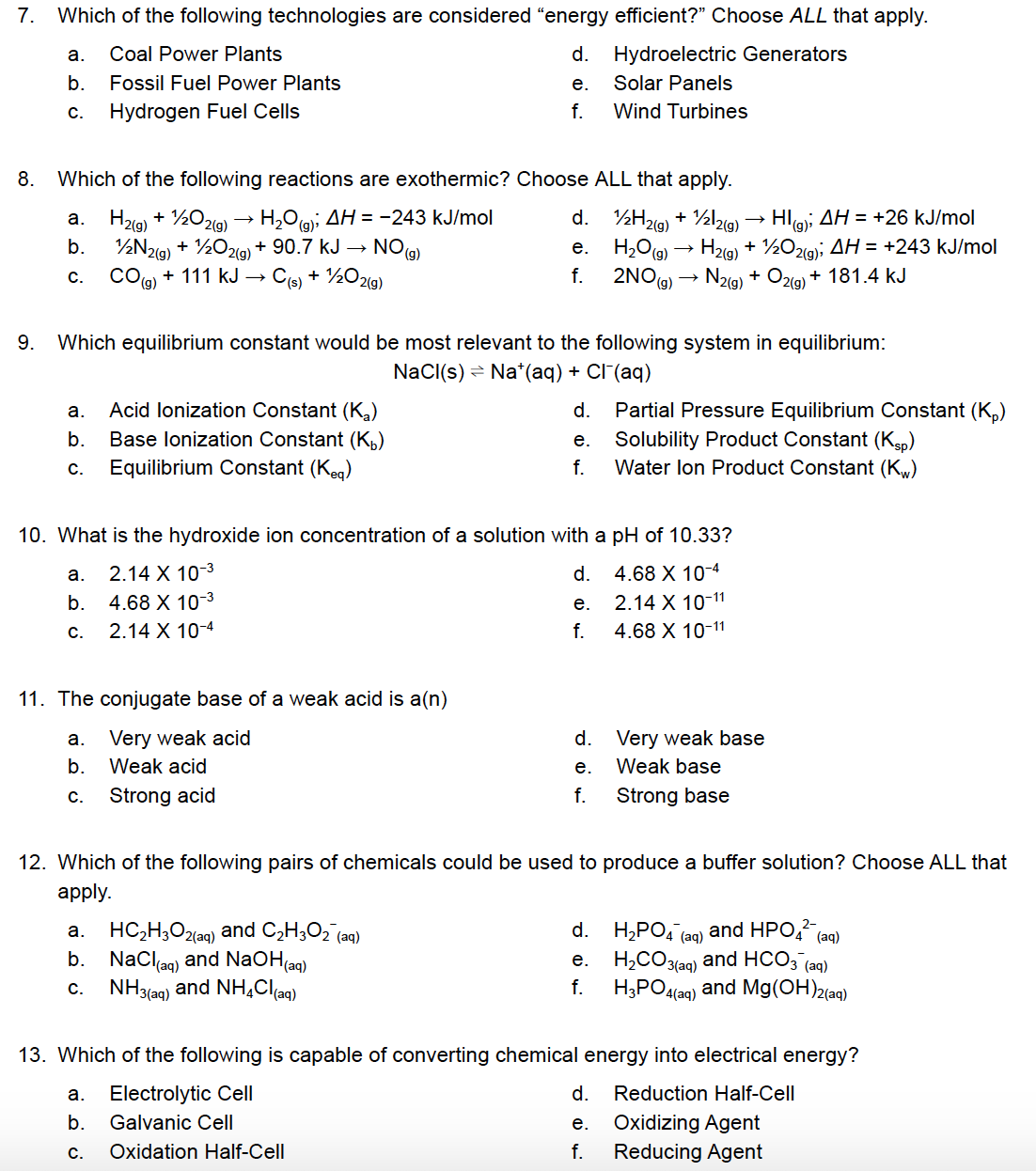7. Which of the following technologies are considered "energy efficient?" Choose ALL that apply. a. Coal Power Plants d. Hydroelectric Generators b. Fossil Fuel Power Plants е. Solar Panels с. Hydrogen Fuel Cells f. Wind Turbines 8. Which of the following reactions are exothermic? Choose ALL that apply. d. ½H29) a. H2(g) + ½O219) → H,O(g); AH = -243 kJ/mol ½N29) + ½O29) + 90.7 kJ → COq) + 111 kJ → C(s) + ½O2(g) + ½l2g) → Hlai AH = +26 kJ/mol H2(9) + ½02g); AH = +243 kJ/mol N2(g) + O29) + 181.4 kJ b. NO (9) е. С. f. 2NO9) 9. Which equilibrium constant would be most relevant to the following system in equilibrium: NaCl(s) = Na*(aq) + Cl´(aq) Acid lonization Constant (K,) Partial Pressure Equilibrium Constant (K, Solubility Product Constant (Kp) f. а. d. b. Base lonization Constant (Kb) е. С. Equilibrium Constant (Kea) Water lon Product Constant (K„) 10. What is the hydroxide ion concentration of a solution with a pH of 10.33? а. 2.14 X 10-3 d. 4.68 X 10-4 b. 4.68 X 10-3 е. 2.14 X 10-11 с. 2.14 X 10-4 f. 4.68 X 10-11 11. The conjugate base of a weak acid is a(n) Very weak acid d. Very weak base а. b. Weak acid е. Weak base C. Strong acid f. Strong base 12. Which of the following pairs of chemicals could be used to produce a buffer solution? Choose ALL tha apply. and C2H3O2 (aq) b. NaClag) and NaOH(aq) NH3(aq) and NH,Clag) HC2H;O2(aq) d. H,PO, and HPO, (aq) а. (аq) е. Н.сОзад) аand HCO; (ag) 3(aq) H3POaq) and Mg(OH)2(aq) с. f. 13. Which of the following is capable of converting chemical energy into electrical energy? a. Electrolytic Cell d. Reduction Half-Cell b. Galvanic Cell е. Oxidizing Agent
Thermochemistry
Thermochemistry can be considered as a branch of thermodynamics that deals with the connections between warmth, work, and various types of energy, formed because of different synthetic and actual cycles. Thermochemistry describes the energy changes that occur as a result of reactions or chemical changes in a substance.
Exergonic Reaction
The term exergonic is derived from the Greek word in which ‘ergon’ means work and exergonic means ‘work outside’. Exergonic reactions releases work energy. Exergonic reactions are different from exothermic reactions, the one that releases only heat energy during the course of the reaction. So, exothermic reaction is one type of exergonic reaction. Exergonic reaction releases work energy in different forms like heat, light or sound. For example, a glow stick releases light making that an exergonic reaction and not an exothermic reaction since no heat is released. Even endothermic reactions at very high temperature are exergonic.

Step by step
Solved in 2 steps with 1 images









